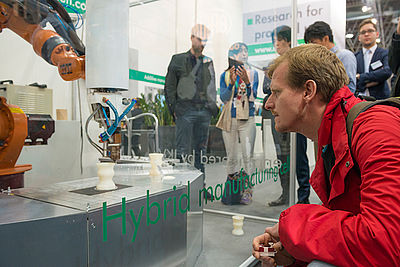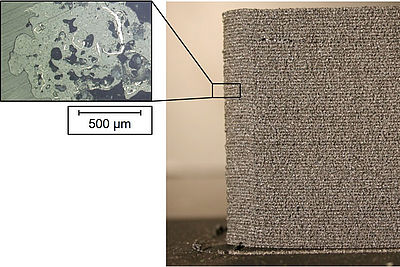Aachen, November 2017 – At the 29th International Colloquium Plastics Technology, the working group on additive manufacturing at the Institute of Plastics Processing (IKV) in Industry and the Skilled Crafts at RWTH Aachen University will present a production cell they have developed for the automated combination of different manufacturing processes. Within this manufacturing cell, high-technology multi-component parts can be produced particularly efficiently. It is noted above all for its high operating productivity thanks to minimised manual intervention and its favourable machine and material productivity. IKV will present its innovative strength in this field with a live demonstration of the production of a fibre-reinforced structural component and an additively manufactured conductor track of highly filled thermoplastics.
Nowadays, a wide variety of different manufacturing processes are used for the production of high-tech multi-component parts, whereby every manufacturing process has its individual advantages and disadvantages. Additive manufacturing, for example, boasts high geometric design freedom and customisation potential in on-demand production. The disadvantages that frequently have to be accepted are moderate surface quality, low dimensional stability with a limited range of materials, plus low productivity. In comparison, manufacturing processes such as machining offer possibilities for minimising the above-described disadvantages on the basis of many years of research and development work. At the end of it all, efficient, customised production is only really possible by deploying the manufacturing processes that best meet the specific requirements.
It is precisely for this purpose that IKV has been working on the development of a production cell for the automatic combination of different production processes (Fig. 1). By utilising a drive unit with an automatic mould change system, the manufacturing process can be switched sequentially. The focus is initially on the combination of the screw-based (plasticising) additive manufacturing process with subtractive production processes and the automated integration of inserts such as thread inserts or electronic components. It is also possible to adapt other production processes through the standardised fixing of the mould. Through intensive R&D work, IKV has succeeded in increasing material output in the melt deposition modelling (MDM) process, and thus raising machine productivity sevenfold compared with conventional processes like the fused layer modelling (FLM) process. The high operating productivity is achieved by wide-ranging automation and thus a minimisation of manual intervention. Finally, the use of highly specialised materials can improve material productivity even further. With its superior efficiency, the new production cell meets the demands of industrial application and makes it very interesting indeed for capital investment.
Contact:
Nicolai Lammert, M.Sc.
Additive manufacturing
phone: +49 241 80-28321
nicolai.lammert@ikv.rwth-aachen.de


